Context of nursing and primary health care
VerifiedAdded on 2023/01/17
|10
|2191
|72
AI Summary
This article discusses the context of nursing and primary health care in Australia, including the services provided, challenges faced, and initiatives taken to improve healthcare access. It also explores the impact of socio-economic status on health and the role of government and non-governmental agencies in addressing health disparities.
Contribute Materials
Your contribution can guide someone’s learning journey. Share your
documents today.

Running head: Context of nursing and primary health care
Context of nursing and primary health care
Name of the Student
Name of the university
Author’s note
Context of nursing and primary health care
Name of the Student
Name of the university
Author’s note
Secure Best Marks with AI Grader
Need help grading? Try our AI Grader for instant feedback on your assignments.
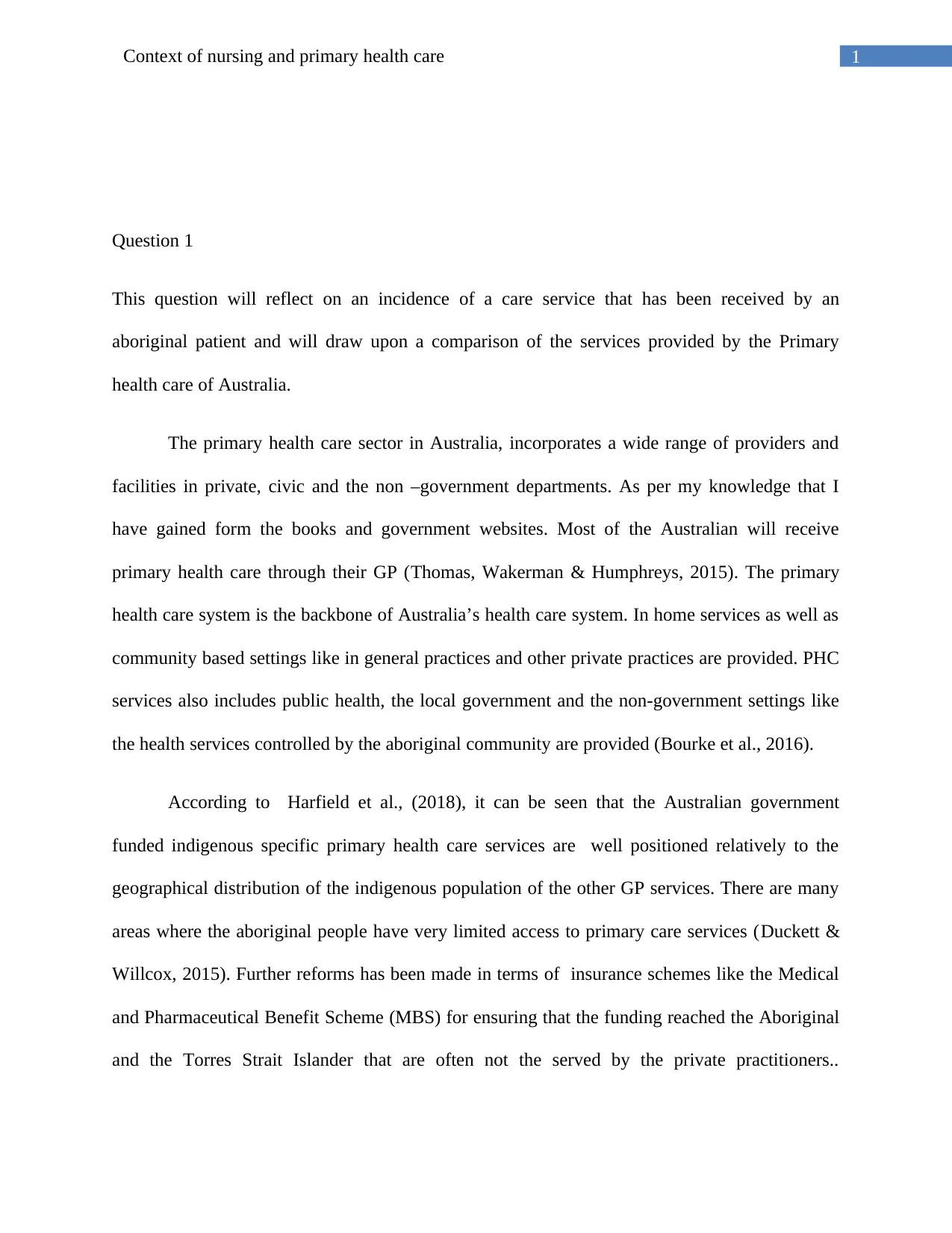
1Context of nursing and primary health care
Question 1
This question will reflect on an incidence of a care service that has been received by an
aboriginal patient and will draw upon a comparison of the services provided by the Primary
health care of Australia.
The primary health care sector in Australia, incorporates a wide range of providers and
facilities in private, civic and the non –government departments. As per my knowledge that I
have gained form the books and government websites. Most of the Australian will receive
primary health care through their GP (Thomas, Wakerman & Humphreys, 2015). The primary
health care system is the backbone of Australia’s health care system. In home services as well as
community based settings like in general practices and other private practices are provided. PHC
services also includes public health, the local government and the non-government settings like
the health services controlled by the aboriginal community are provided (Bourke et al., 2016).
According to Harfield et al., (2018), it can be seen that the Australian government
funded indigenous specific primary health care services are well positioned relatively to the
geographical distribution of the indigenous population of the other GP services. There are many
areas where the aboriginal people have very limited access to primary care services (Duckett &
Willcox, 2015). Further reforms has been made in terms of insurance schemes like the Medical
and Pharmaceutical Benefit Scheme (MBS) for ensuring that the funding reached the Aboriginal
and the Torres Strait Islander that are often not the served by the private practitioners..
Question 1
This question will reflect on an incidence of a care service that has been received by an
aboriginal patient and will draw upon a comparison of the services provided by the Primary
health care of Australia.
The primary health care sector in Australia, incorporates a wide range of providers and
facilities in private, civic and the non –government departments. As per my knowledge that I
have gained form the books and government websites. Most of the Australian will receive
primary health care through their GP (Thomas, Wakerman & Humphreys, 2015). The primary
health care system is the backbone of Australia’s health care system. In home services as well as
community based settings like in general practices and other private practices are provided. PHC
services also includes public health, the local government and the non-government settings like
the health services controlled by the aboriginal community are provided (Bourke et al., 2016).
According to Harfield et al., (2018), it can be seen that the Australian government
funded indigenous specific primary health care services are well positioned relatively to the
geographical distribution of the indigenous population of the other GP services. There are many
areas where the aboriginal people have very limited access to primary care services (Duckett &
Willcox, 2015). Further reforms has been made in terms of insurance schemes like the Medical
and Pharmaceutical Benefit Scheme (MBS) for ensuring that the funding reached the Aboriginal
and the Torres Strait Islander that are often not the served by the private practitioners..
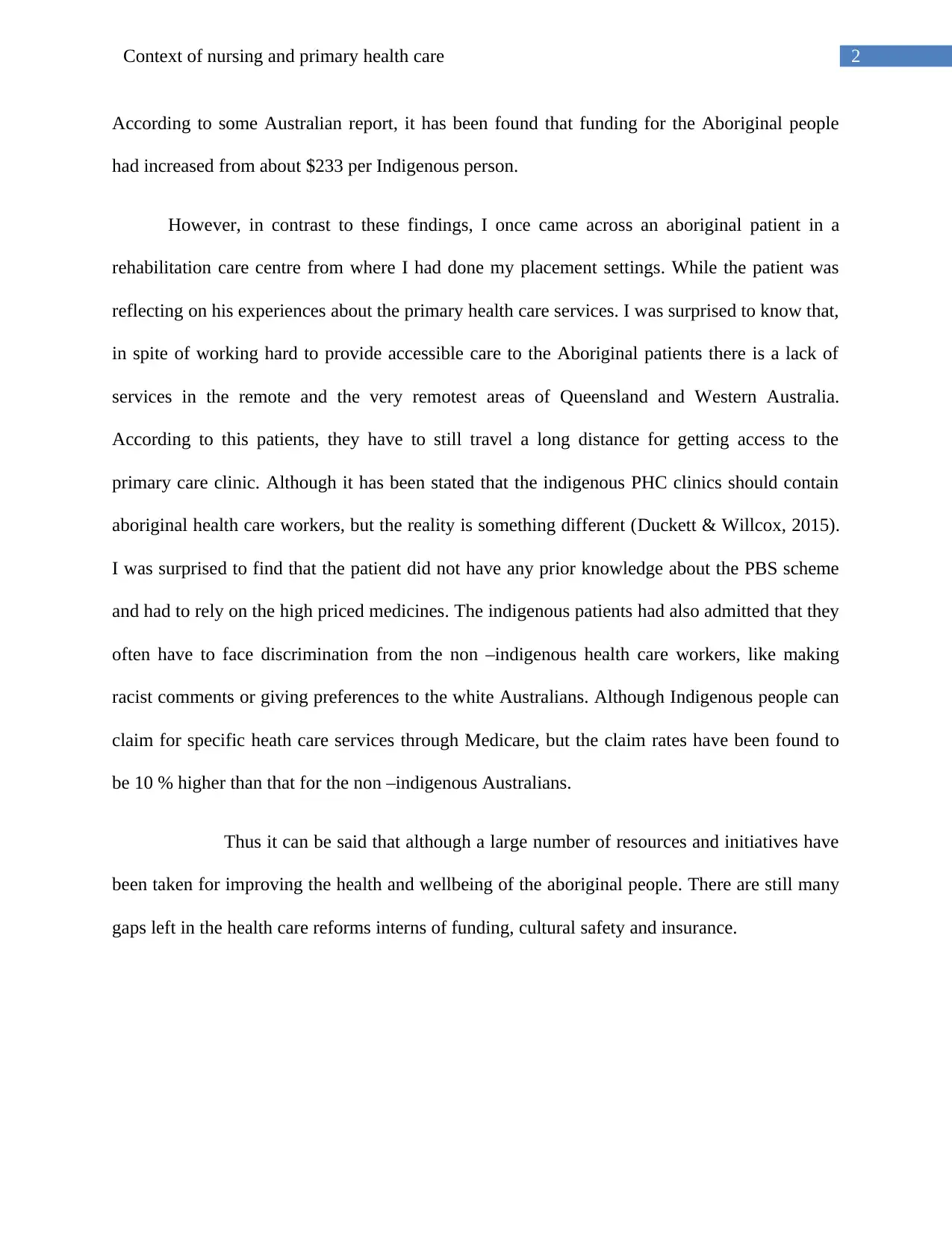
2Context of nursing and primary health care
According to some Australian report, it has been found that funding for the Aboriginal people
had increased from about $233 per Indigenous person.
However, in contrast to these findings, I once came across an aboriginal patient in a
rehabilitation care centre from where I had done my placement settings. While the patient was
reflecting on his experiences about the primary health care services. I was surprised to know that,
in spite of working hard to provide accessible care to the Aboriginal patients there is a lack of
services in the remote and the very remotest areas of Queensland and Western Australia.
According to this patients, they have to still travel a long distance for getting access to the
primary care clinic. Although it has been stated that the indigenous PHC clinics should contain
aboriginal health care workers, but the reality is something different (Duckett & Willcox, 2015).
I was surprised to find that the patient did not have any prior knowledge about the PBS scheme
and had to rely on the high priced medicines. The indigenous patients had also admitted that they
often have to face discrimination from the non –indigenous health care workers, like making
racist comments or giving preferences to the white Australians. Although Indigenous people can
claim for specific heath care services through Medicare, but the claim rates have been found to
be 10 % higher than that for the non –indigenous Australians.
Thus it can be said that although a large number of resources and initiatives have
been taken for improving the health and wellbeing of the aboriginal people. There are still many
gaps left in the health care reforms interns of funding, cultural safety and insurance.
According to some Australian report, it has been found that funding for the Aboriginal people
had increased from about $233 per Indigenous person.
However, in contrast to these findings, I once came across an aboriginal patient in a
rehabilitation care centre from where I had done my placement settings. While the patient was
reflecting on his experiences about the primary health care services. I was surprised to know that,
in spite of working hard to provide accessible care to the Aboriginal patients there is a lack of
services in the remote and the very remotest areas of Queensland and Western Australia.
According to this patients, they have to still travel a long distance for getting access to the
primary care clinic. Although it has been stated that the indigenous PHC clinics should contain
aboriginal health care workers, but the reality is something different (Duckett & Willcox, 2015).
I was surprised to find that the patient did not have any prior knowledge about the PBS scheme
and had to rely on the high priced medicines. The indigenous patients had also admitted that they
often have to face discrimination from the non –indigenous health care workers, like making
racist comments or giving preferences to the white Australians. Although Indigenous people can
claim for specific heath care services through Medicare, but the claim rates have been found to
be 10 % higher than that for the non –indigenous Australians.
Thus it can be said that although a large number of resources and initiatives have
been taken for improving the health and wellbeing of the aboriginal people. There are still many
gaps left in the health care reforms interns of funding, cultural safety and insurance.
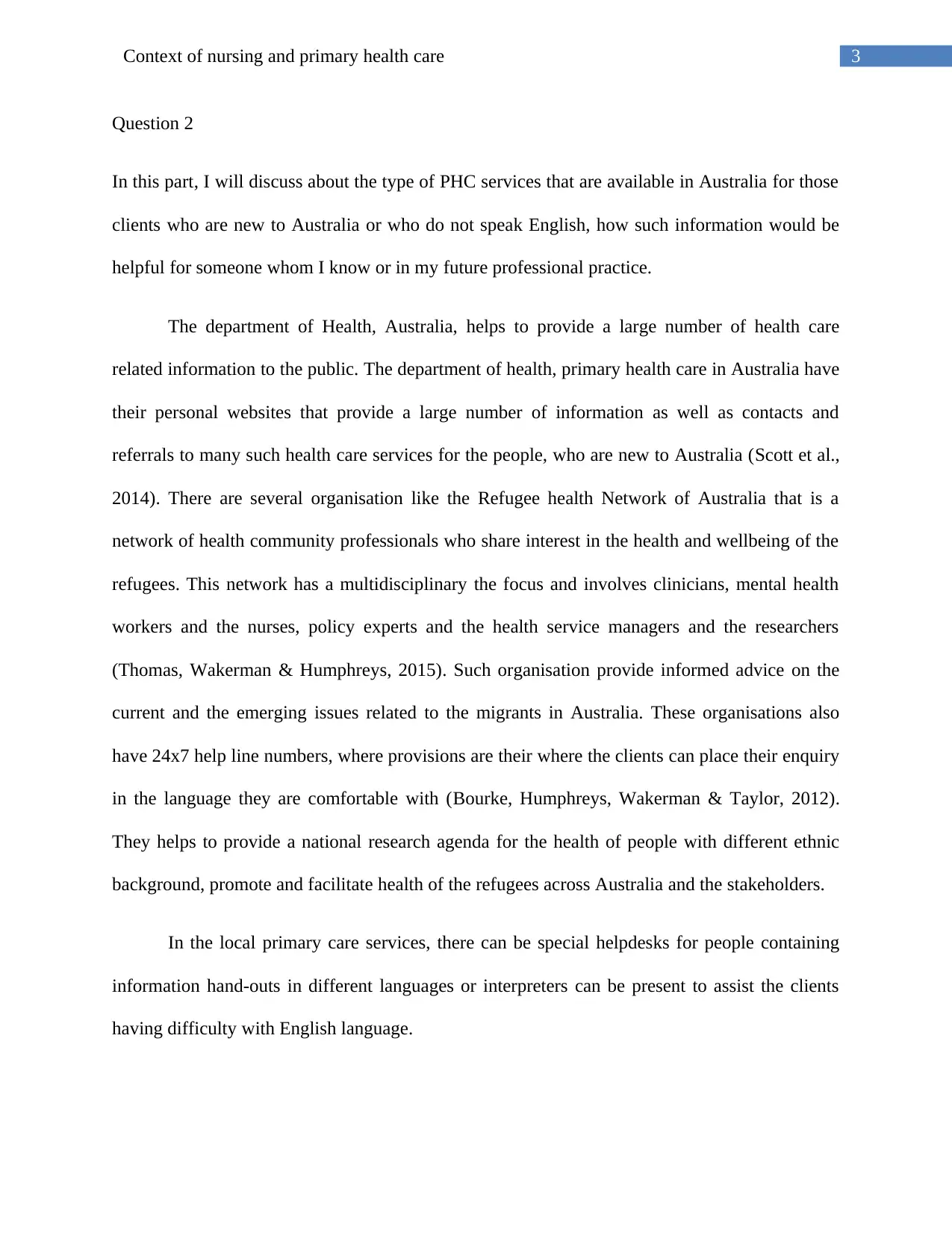
3Context of nursing and primary health care
Question 2
In this part, I will discuss about the type of PHC services that are available in Australia for those
clients who are new to Australia or who do not speak English, how such information would be
helpful for someone whom I know or in my future professional practice.
The department of Health, Australia, helps to provide a large number of health care
related information to the public. The department of health, primary health care in Australia have
their personal websites that provide a large number of information as well as contacts and
referrals to many such health care services for the people, who are new to Australia (Scott et al.,
2014). There are several organisation like the Refugee health Network of Australia that is a
network of health community professionals who share interest in the health and wellbeing of the
refugees. This network has a multidisciplinary the focus and involves clinicians, mental health
workers and the nurses, policy experts and the health service managers and the researchers
(Thomas, Wakerman & Humphreys, 2015). Such organisation provide informed advice on the
current and the emerging issues related to the migrants in Australia. These organisations also
have 24x7 help line numbers, where provisions are their where the clients can place their enquiry
in the language they are comfortable with (Bourke, Humphreys, Wakerman & Taylor, 2012).
They helps to provide a national research agenda for the health of people with different ethnic
background, promote and facilitate health of the refugees across Australia and the stakeholders.
In the local primary care services, there can be special helpdesks for people containing
information hand-outs in different languages or interpreters can be present to assist the clients
having difficulty with English language.
Question 2
In this part, I will discuss about the type of PHC services that are available in Australia for those
clients who are new to Australia or who do not speak English, how such information would be
helpful for someone whom I know or in my future professional practice.
The department of Health, Australia, helps to provide a large number of health care
related information to the public. The department of health, primary health care in Australia have
their personal websites that provide a large number of information as well as contacts and
referrals to many such health care services for the people, who are new to Australia (Scott et al.,
2014). There are several organisation like the Refugee health Network of Australia that is a
network of health community professionals who share interest in the health and wellbeing of the
refugees. This network has a multidisciplinary the focus and involves clinicians, mental health
workers and the nurses, policy experts and the health service managers and the researchers
(Thomas, Wakerman & Humphreys, 2015). Such organisation provide informed advice on the
current and the emerging issues related to the migrants in Australia. These organisations also
have 24x7 help line numbers, where provisions are their where the clients can place their enquiry
in the language they are comfortable with (Bourke, Humphreys, Wakerman & Taylor, 2012).
They helps to provide a national research agenda for the health of people with different ethnic
background, promote and facilitate health of the refugees across Australia and the stakeholders.
In the local primary care services, there can be special helpdesks for people containing
information hand-outs in different languages or interpreters can be present to assist the clients
having difficulty with English language.
Secure Best Marks with AI Grader
Need help grading? Try our AI Grader for instant feedback on your assignments.
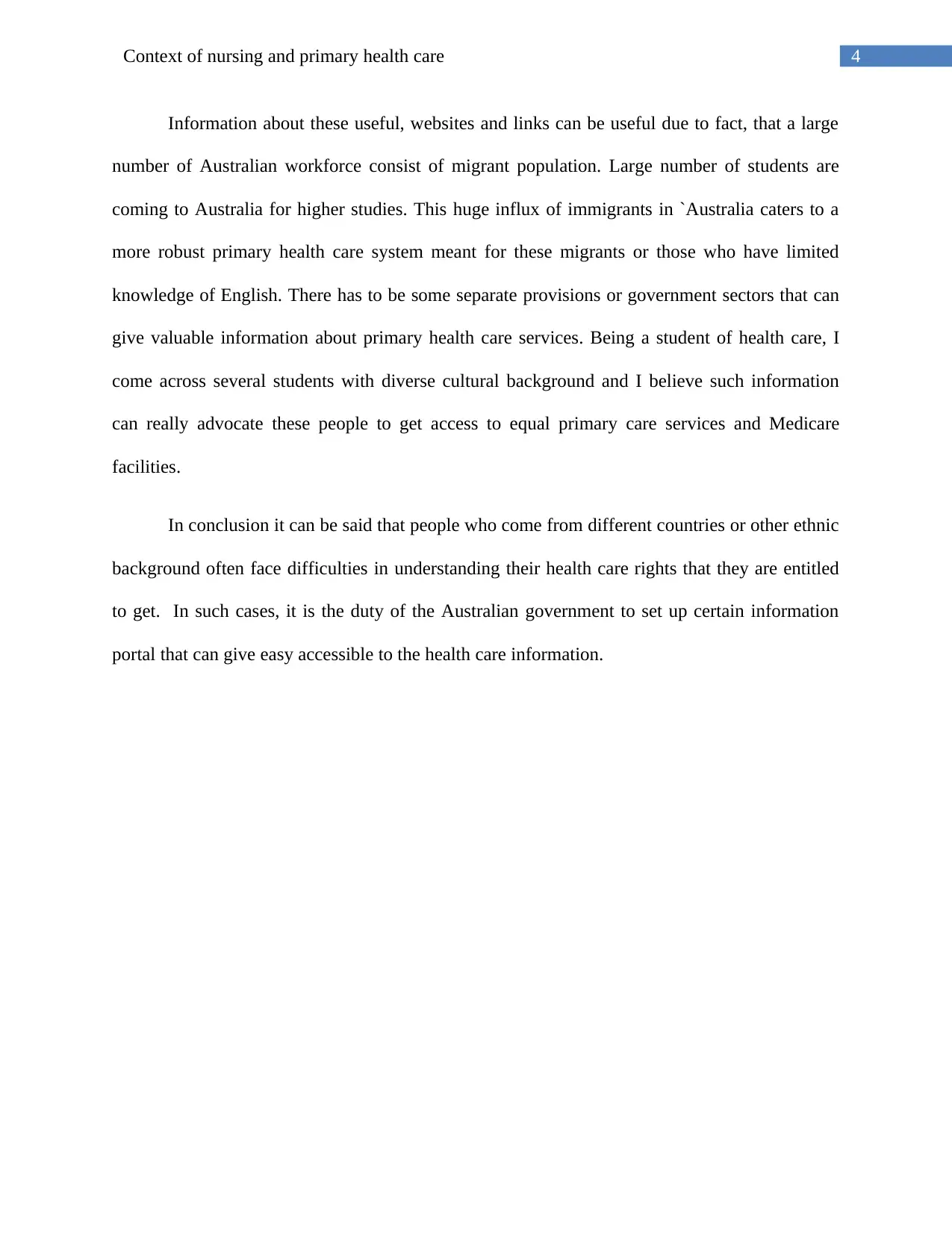
4Context of nursing and primary health care
Information about these useful, websites and links can be useful due to fact, that a large
number of Australian workforce consist of migrant population. Large number of students are
coming to Australia for higher studies. This huge influx of immigrants in `Australia caters to a
more robust primary health care system meant for these migrants or those who have limited
knowledge of English. There has to be some separate provisions or government sectors that can
give valuable information about primary health care services. Being a student of health care, I
come across several students with diverse cultural background and I believe such information
can really advocate these people to get access to equal primary care services and Medicare
facilities.
In conclusion it can be said that people who come from different countries or other ethnic
background often face difficulties in understanding their health care rights that they are entitled
to get. In such cases, it is the duty of the Australian government to set up certain information
portal that can give easy accessible to the health care information.
Information about these useful, websites and links can be useful due to fact, that a large
number of Australian workforce consist of migrant population. Large number of students are
coming to Australia for higher studies. This huge influx of immigrants in `Australia caters to a
more robust primary health care system meant for these migrants or those who have limited
knowledge of English. There has to be some separate provisions or government sectors that can
give valuable information about primary health care services. Being a student of health care, I
come across several students with diverse cultural background and I believe such information
can really advocate these people to get access to equal primary care services and Medicare
facilities.
In conclusion it can be said that people who come from different countries or other ethnic
background often face difficulties in understanding their health care rights that they are entitled
to get. In such cases, it is the duty of the Australian government to set up certain information
portal that can give easy accessible to the health care information.
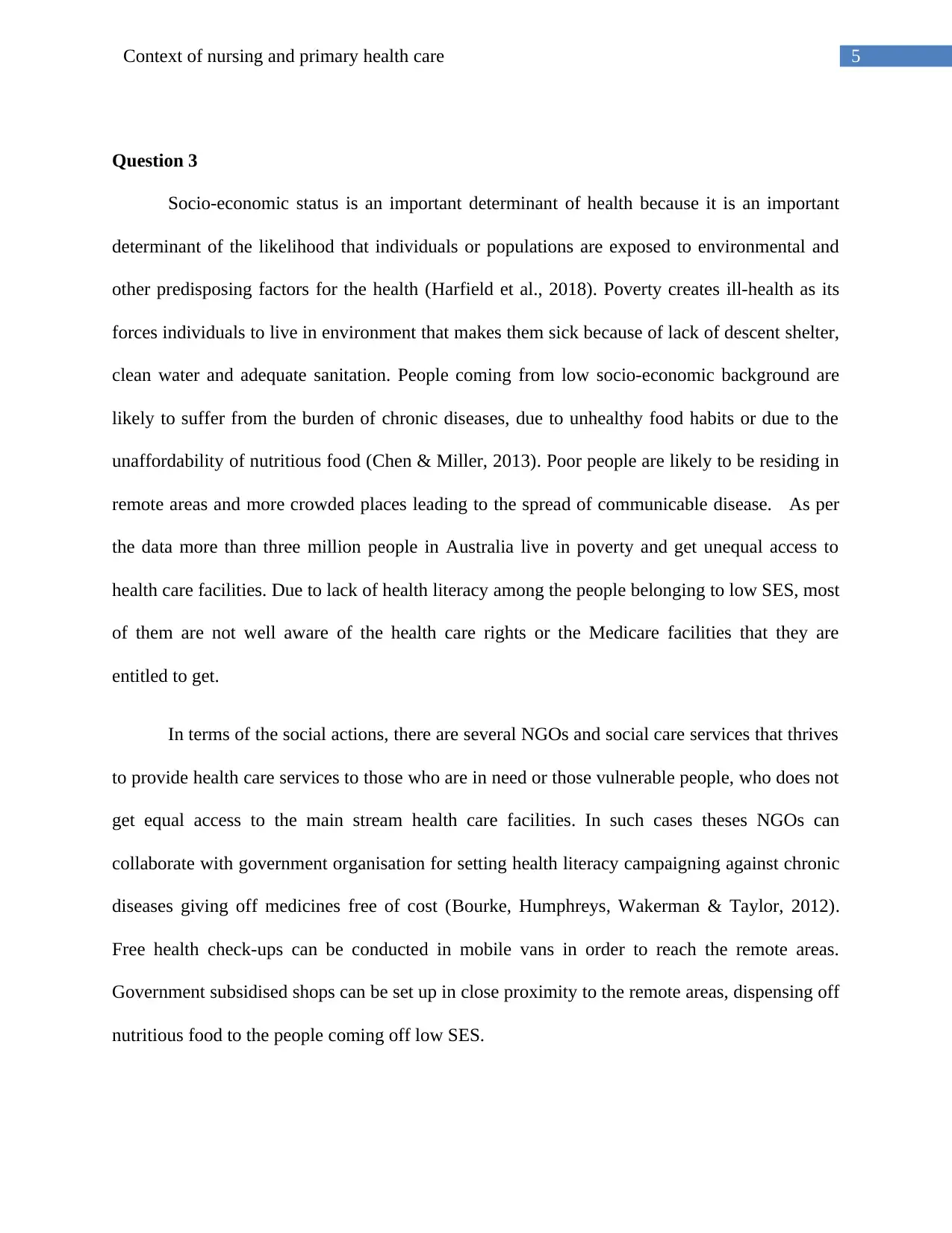
5Context of nursing and primary health care
Question 3
Socio-economic status is an important determinant of health because it is an important
determinant of the likelihood that individuals or populations are exposed to environmental and
other predisposing factors for the health (Harfield et al., 2018). Poverty creates ill-health as its
forces individuals to live in environment that makes them sick because of lack of descent shelter,
clean water and adequate sanitation. People coming from low socio-economic background are
likely to suffer from the burden of chronic diseases, due to unhealthy food habits or due to the
unaffordability of nutritious food (Chen & Miller, 2013). Poor people are likely to be residing in
remote areas and more crowded places leading to the spread of communicable disease. As per
the data more than three million people in Australia live in poverty and get unequal access to
health care facilities. Due to lack of health literacy among the people belonging to low SES, most
of them are not well aware of the health care rights or the Medicare facilities that they are
entitled to get.
In terms of the social actions, there are several NGOs and social care services that thrives
to provide health care services to those who are in need or those vulnerable people, who does not
get equal access to the main stream health care facilities. In such cases theses NGOs can
collaborate with government organisation for setting health literacy campaigning against chronic
diseases giving off medicines free of cost (Bourke, Humphreys, Wakerman & Taylor, 2012).
Free health check-ups can be conducted in mobile vans in order to reach the remote areas.
Government subsidised shops can be set up in close proximity to the remote areas, dispensing off
nutritious food to the people coming off low SES.
Question 3
Socio-economic status is an important determinant of health because it is an important
determinant of the likelihood that individuals or populations are exposed to environmental and
other predisposing factors for the health (Harfield et al., 2018). Poverty creates ill-health as its
forces individuals to live in environment that makes them sick because of lack of descent shelter,
clean water and adequate sanitation. People coming from low socio-economic background are
likely to suffer from the burden of chronic diseases, due to unhealthy food habits or due to the
unaffordability of nutritious food (Chen & Miller, 2013). Poor people are likely to be residing in
remote areas and more crowded places leading to the spread of communicable disease. As per
the data more than three million people in Australia live in poverty and get unequal access to
health care facilities. Due to lack of health literacy among the people belonging to low SES, most
of them are not well aware of the health care rights or the Medicare facilities that they are
entitled to get.
In terms of the social actions, there are several NGOs and social care services that thrives
to provide health care services to those who are in need or those vulnerable people, who does not
get equal access to the main stream health care facilities. In such cases theses NGOs can
collaborate with government organisation for setting health literacy campaigning against chronic
diseases giving off medicines free of cost (Bourke, Humphreys, Wakerman & Taylor, 2012).
Free health check-ups can be conducted in mobile vans in order to reach the remote areas.
Government subsidised shops can be set up in close proximity to the remote areas, dispensing off
nutritious food to the people coming off low SES.
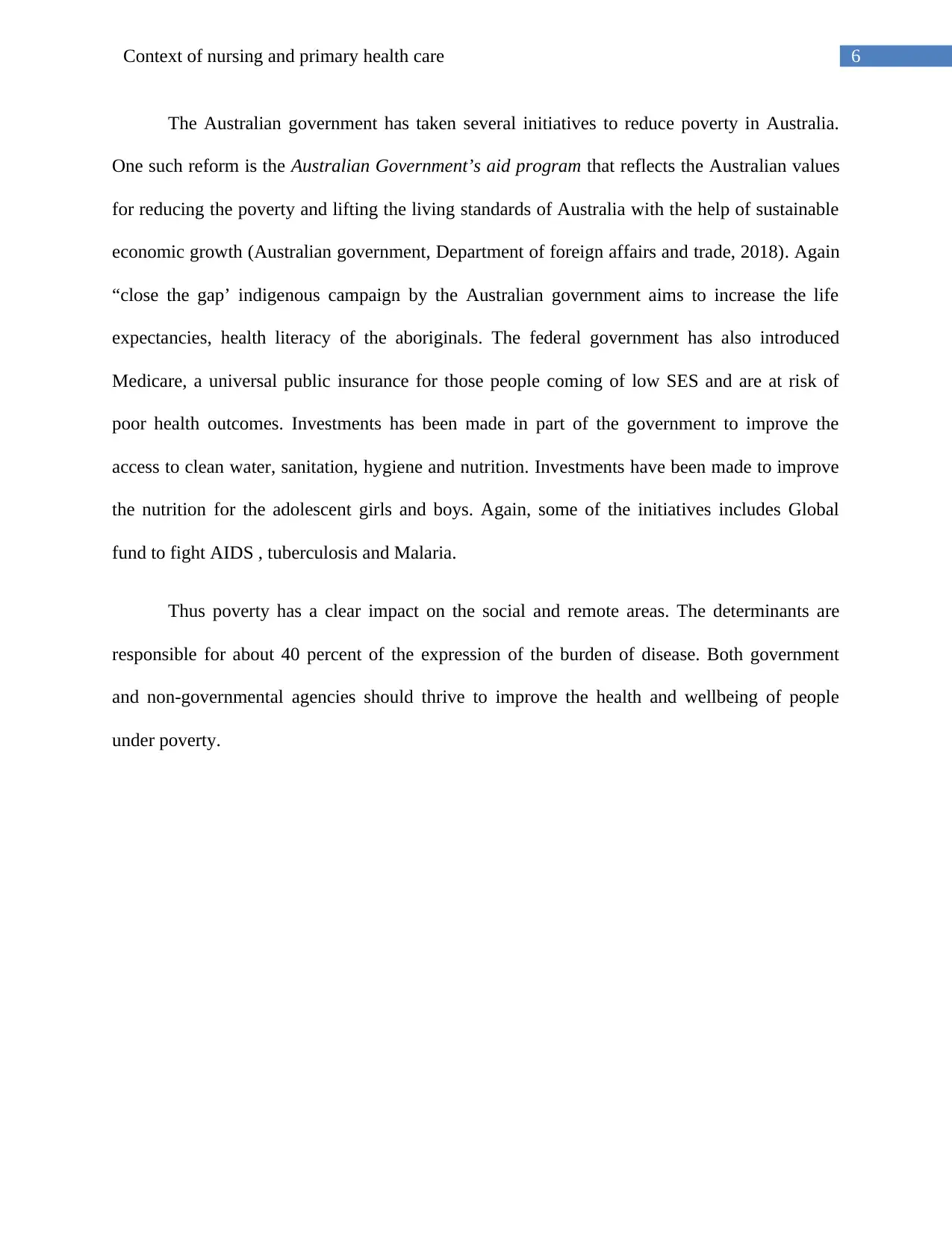
6Context of nursing and primary health care
The Australian government has taken several initiatives to reduce poverty in Australia.
One such reform is the Australian Government’s aid program that reflects the Australian values
for reducing the poverty and lifting the living standards of Australia with the help of sustainable
economic growth (Australian government, Department of foreign affairs and trade, 2018). Again
“close the gap’ indigenous campaign by the Australian government aims to increase the life
expectancies, health literacy of the aboriginals. The federal government has also introduced
Medicare, a universal public insurance for those people coming of low SES and are at risk of
poor health outcomes. Investments has been made in part of the government to improve the
access to clean water, sanitation, hygiene and nutrition. Investments have been made to improve
the nutrition for the adolescent girls and boys. Again, some of the initiatives includes Global
fund to fight AIDS , tuberculosis and Malaria.
Thus poverty has a clear impact on the social and remote areas. The determinants are
responsible for about 40 percent of the expression of the burden of disease. Both government
and non-governmental agencies should thrive to improve the health and wellbeing of people
under poverty.
The Australian government has taken several initiatives to reduce poverty in Australia.
One such reform is the Australian Government’s aid program that reflects the Australian values
for reducing the poverty and lifting the living standards of Australia with the help of sustainable
economic growth (Australian government, Department of foreign affairs and trade, 2018). Again
“close the gap’ indigenous campaign by the Australian government aims to increase the life
expectancies, health literacy of the aboriginals. The federal government has also introduced
Medicare, a universal public insurance for those people coming of low SES and are at risk of
poor health outcomes. Investments has been made in part of the government to improve the
access to clean water, sanitation, hygiene and nutrition. Investments have been made to improve
the nutrition for the adolescent girls and boys. Again, some of the initiatives includes Global
fund to fight AIDS , tuberculosis and Malaria.
Thus poverty has a clear impact on the social and remote areas. The determinants are
responsible for about 40 percent of the expression of the burden of disease. Both government
and non-governmental agencies should thrive to improve the health and wellbeing of people
under poverty.
Paraphrase This Document
Need a fresh take? Get an instant paraphrase of this document with our AI Paraphraser
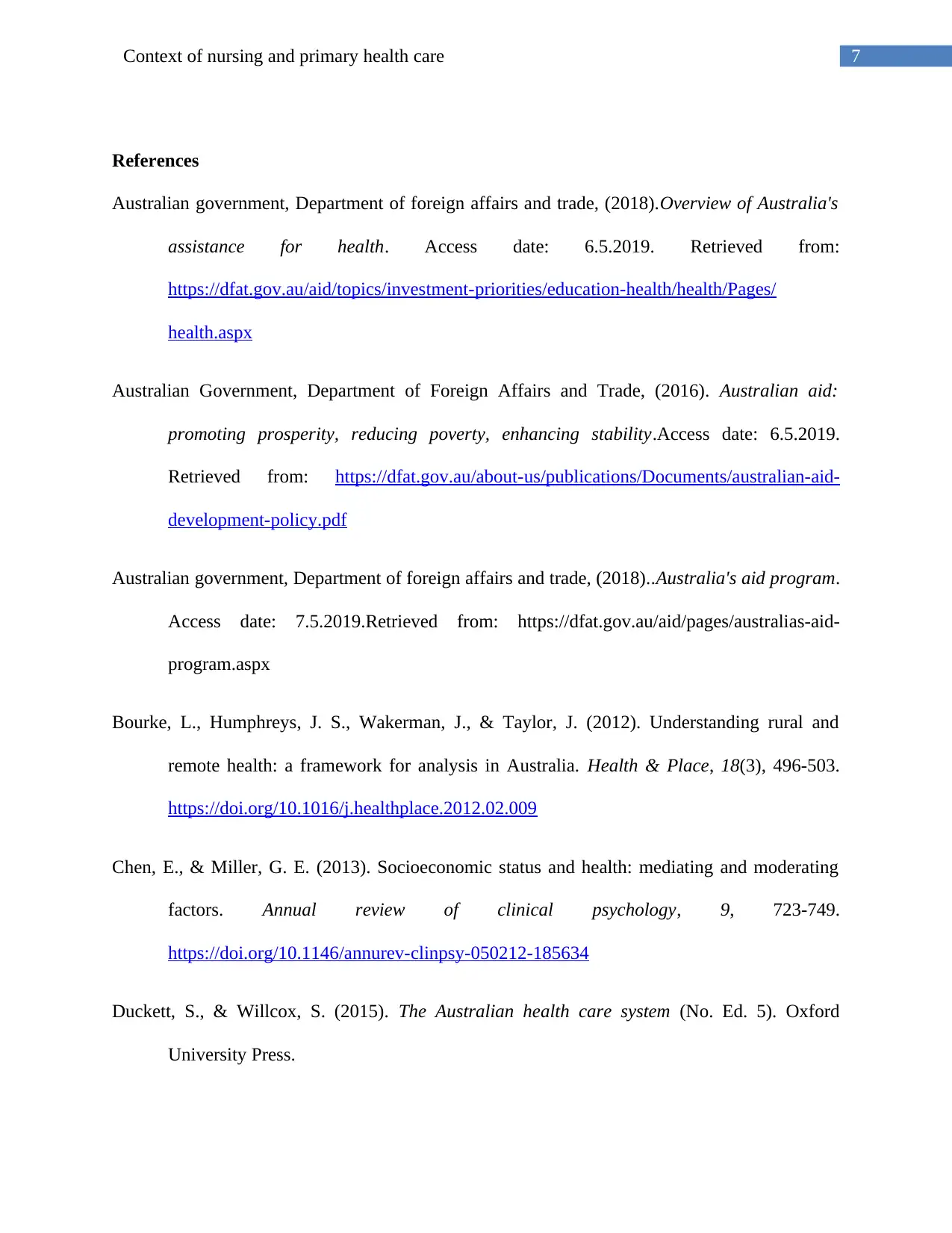
7Context of nursing and primary health care
References
Australian government, Department of foreign affairs and trade, (2018).Overview of Australia's
assistance for health. Access date: 6.5.2019. Retrieved from:
https://dfat.gov.au/aid/topics/investment-priorities/education-health/health/Pages/
health.aspx
Australian Government, Department of Foreign Affairs and Trade, (2016). Australian aid:
promoting prosperity, reducing poverty, enhancing stability.Access date: 6.5.2019.
Retrieved from: https://dfat.gov.au/about-us/publications/Documents/australian-aid-
development-policy.pdf
Australian government, Department of foreign affairs and trade, (2018)..Australia's aid program.
Access date: 7.5.2019.Retrieved from: https://dfat.gov.au/aid/pages/australias-aid-
program.aspx
Bourke, L., Humphreys, J. S., Wakerman, J., & Taylor, J. (2012). Understanding rural and
remote health: a framework for analysis in Australia. Health & Place, 18(3), 496-503.
https://doi.org/10.1016/j.healthplace.2012.02.009
Chen, E., & Miller, G. E. (2013). Socioeconomic status and health: mediating and moderating
factors. Annual review of clinical psychology, 9, 723-749.
https://doi.org/10.1146/annurev-clinpsy-050212-185634
Duckett, S., & Willcox, S. (2015). The Australian health care system (No. Ed. 5). Oxford
University Press.
References
Australian government, Department of foreign affairs and trade, (2018).Overview of Australia's
assistance for health. Access date: 6.5.2019. Retrieved from:
https://dfat.gov.au/aid/topics/investment-priorities/education-health/health/Pages/
health.aspx
Australian Government, Department of Foreign Affairs and Trade, (2016). Australian aid:
promoting prosperity, reducing poverty, enhancing stability.Access date: 6.5.2019.
Retrieved from: https://dfat.gov.au/about-us/publications/Documents/australian-aid-
development-policy.pdf
Australian government, Department of foreign affairs and trade, (2018)..Australia's aid program.
Access date: 7.5.2019.Retrieved from: https://dfat.gov.au/aid/pages/australias-aid-
program.aspx
Bourke, L., Humphreys, J. S., Wakerman, J., & Taylor, J. (2012). Understanding rural and
remote health: a framework for analysis in Australia. Health & Place, 18(3), 496-503.
https://doi.org/10.1016/j.healthplace.2012.02.009
Chen, E., & Miller, G. E. (2013). Socioeconomic status and health: mediating and moderating
factors. Annual review of clinical psychology, 9, 723-749.
https://doi.org/10.1146/annurev-clinpsy-050212-185634
Duckett, S., & Willcox, S. (2015). The Australian health care system (No. Ed. 5). Oxford
University Press.

8Context of nursing and primary health care
Fuller-Rowell, T. E., Evans, G. W., & Ong, A. D. (2012). Poverty and health: The mediating role
of perceived discrimination. Psychological Science, 23(7), 734-739.
https://doi.org/10.1177/0956797612439720
Harfield, S. G., Davy, C., McArthur, A., Munn, Z., Brown, A., & Brown, N. (2018).
Characteristics of Indigenous primary health care service delivery models: a systematic
scoping review. Globalization and health, 14(1), 12. doi:10.1186/s12992-018-0332-2
Knight, A. W., Caesar, C., Ford, D., Coughlin, A., & Frick, C. (2012). Improving primary care in
Australia through the Australian Primary Care Collaboratives Program: a quality
improvement report. BMJ quality & safety, 21(11), 948-955.
http://dx.doi.org/10.1136/bmjqs-2011-000165
Scott, E. M., Hermens, D. F., Glozier, N., Naismith, S. L., Guastella, A. J., & Hickie, I. B.
(2012). Targeted primary care‐based mental health services for young Australians.
Medical Journal of Australia, 196(2), 136-140. https://doi.org/10.5694/mja11.10481
Thomas, S. L., Wakerman, J., & Humphreys, J. S. (2015). Ensuring equity of access to primary
health care in rural and remote Australia-what core services should be locally available?.
International journal for equity in health, 14(1), 111. https://doi.org/10.1186/s12939-
015-0228-1
Fuller-Rowell, T. E., Evans, G. W., & Ong, A. D. (2012). Poverty and health: The mediating role
of perceived discrimination. Psychological Science, 23(7), 734-739.
https://doi.org/10.1177/0956797612439720
Harfield, S. G., Davy, C., McArthur, A., Munn, Z., Brown, A., & Brown, N. (2018).
Characteristics of Indigenous primary health care service delivery models: a systematic
scoping review. Globalization and health, 14(1), 12. doi:10.1186/s12992-018-0332-2
Knight, A. W., Caesar, C., Ford, D., Coughlin, A., & Frick, C. (2012). Improving primary care in
Australia through the Australian Primary Care Collaboratives Program: a quality
improvement report. BMJ quality & safety, 21(11), 948-955.
http://dx.doi.org/10.1136/bmjqs-2011-000165
Scott, E. M., Hermens, D. F., Glozier, N., Naismith, S. L., Guastella, A. J., & Hickie, I. B.
(2012). Targeted primary care‐based mental health services for young Australians.
Medical Journal of Australia, 196(2), 136-140. https://doi.org/10.5694/mja11.10481
Thomas, S. L., Wakerman, J., & Humphreys, J. S. (2015). Ensuring equity of access to primary
health care in rural and remote Australia-what core services should be locally available?.
International journal for equity in health, 14(1), 111. https://doi.org/10.1186/s12939-
015-0228-1
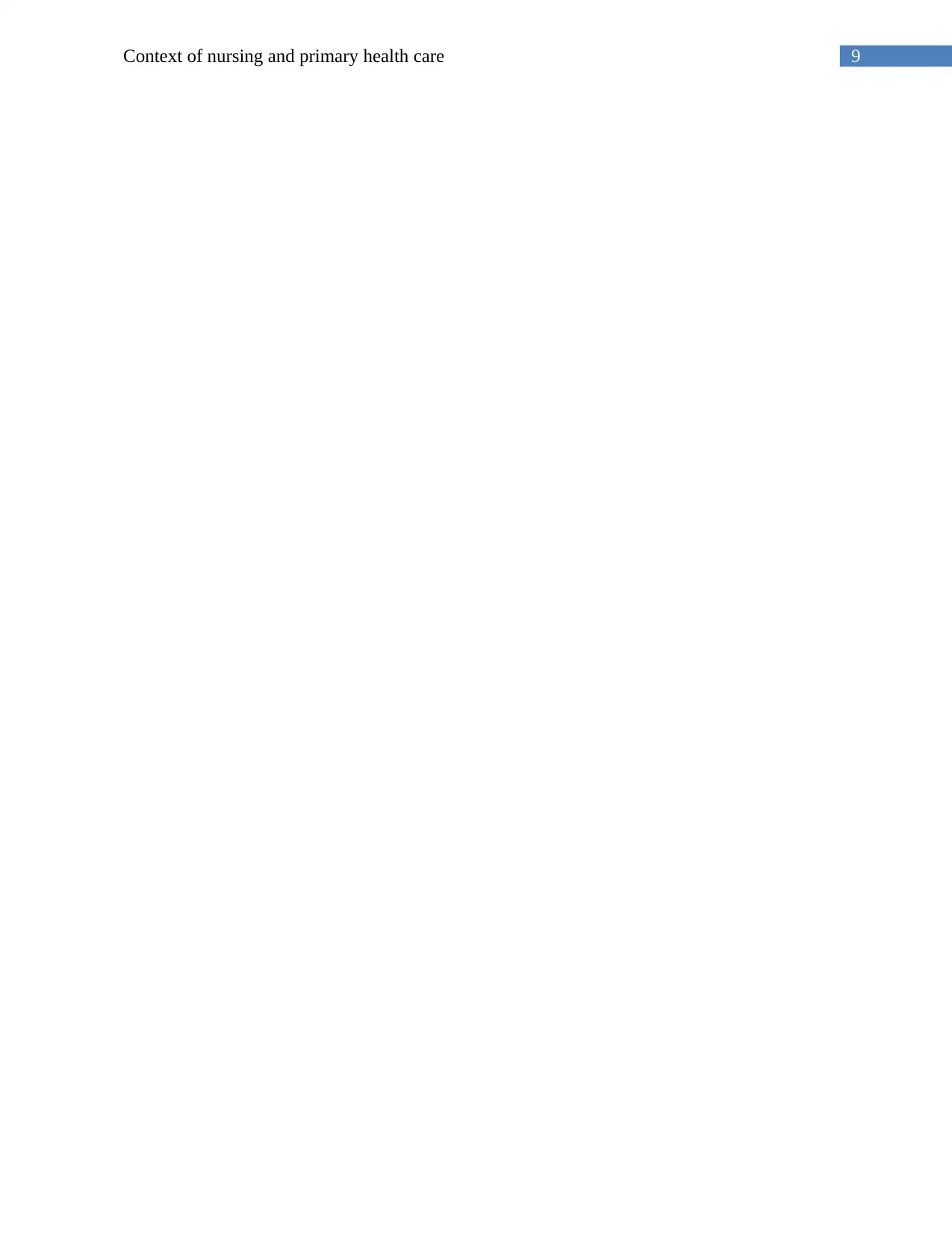
9Context of nursing and primary health care
1 out of 10
Related Documents
Your All-in-One AI-Powered Toolkit for Academic Success.
+13062052269
info@desklib.com
Available 24*7 on WhatsApp / Email
![[object Object]](/_next/static/media/star-bottom.7253800d.svg)
Unlock your academic potential
© 2024 | Zucol Services PVT LTD | All rights reserved.





